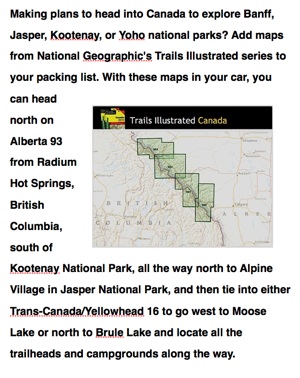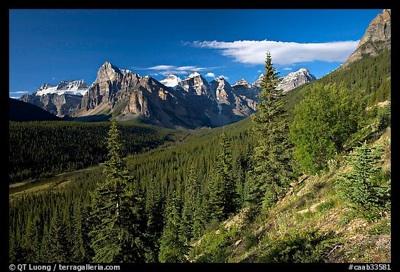Editor's note: From time to time we offer Traveler's readers articles on parks abroad, both to explore the wonders that can be found outside the U.S. park system and to see how other countries approach park management. With Parks Canada this year celebrating the 125th anniversary of Canada's national park movement and looking forward to its own centennial next year, it seems appropriate to look at a variety of topics involving Parks Canada and some of its parks.
Hopscotch the crags of the Rocky Mountains north from Glacier National Park across the border into Canada and you'll find yourself in a mountainous realm, one cupping lakes slowly being fed by melting glaciers and with verdant forests rich in wildlife. Canada's national parks just north of Montana -- Kootenay, Banff, and Waterton Lakes -- are incredibly rugged cousins of Glacier. Here the landscapes are dominated by rocky ramparts that appear as storm-tossed waves of geology that tilt and bank high over slopes of scree and forests of pine, spruce, aspen and streams, rivers, and lakes. Some lakes and rivers are tinted hues of turquoise and aquamarine by glacial silt ground out of the mountains by rivers of ice that, while in retreat, still appear rather stupendous from down below.
A trio spanning 3,297 square miles -- 2.1 million acres, or roughly the size of Yellowstone -- the parks have much in common with Glacier and other U.S. national parks...and some aspects that U.S. park-goers don’t encounter.
* For instance, to help wildlife negotiate major highways such as the Trans-Canada Highway that traverses Banff National Park as they follow their innate migratory corridors, Canadians build wildlife bridges that span the highways. Appearing like huge culverts laid across the highways, these curved spans are covered with dirt and planted with shrubs, trees, and grasses to make wildlife feel at home as they roam north and south.
* Communities and bustling towns -- not just villages catering to park-goers -- grew up with some of the parks. Banff is a prime example. This rollicking town of less than 2 square miles and with nearly 7,000 permanent residents has much in appearance with places such as Aspen, Sun Valley, or Park City. And yet, it's surrounded by Banff National Park. The surrounding scenery, the placid Bow River and the Vermillion Lakes, make for a breathtaking setting. But how comfortable would it be to see such a diverse and vibrant community within any U.S. national park?

A new set of Trails Illustrated maps has arrived to help you navigate Kootenay, Banff, Yoho and Jasper national parks along the spine of the Rockies in Canada.
* Parks Canada also is more aggressive with its entrance-fee pricing than the National Park Service. While $20 or $25 will gain you and your family a week’s entrance into such U.S. parks as Yellowstone, Yosemite, and Grand Canyon, in Canada it costs nearly $20 a day for a family or group to enter some parks, with individual daily fees varying from $7.80 per adult for Waterton Lakes to $9.80 per adult at Banff and Kootenay.
“The pricing structure for parks Canada is essentially based on three factors. One is obviously the value. The prices reflect the quality and the level of services and the benefits to the visitors,” said Robert Loken, Parks Canada’s manager for visitor services. “The second factor being comparability. We compare the fees charged nationally and internationally at other quality heritage attractions with similar type services and experiences.
“And then, obviously, we look at the cost of the services. Our prices never exceed the full cost of delivering the service, which is consistent with the Canadian federal government policy,” he added.
While the National Park Service will sell you an America the Beautiful Pass for $80 that gets you and your clan, for one year, into each and every unit of the National Park System as many times as you like, the annual pass sold by Parks Canada runs $106.90 for a family, $53 for adults.
* Just as the National Park Service had instituted a freeze on entrance fee levels to encourage visitation, so, too, has Parks Canada.
“We instituted a fee freeze in 2008, which will remain in place until 2011, allowing, obviously, our visitors to appreciate the national wonders that we have during these challenging economic times,” Mr. Loken said.
There are, of course, other similarities between the two park systems in both scenery and issues that spawn controversy. Just as the National Park Service is grappling with how much Wi-Fi is a good thing, so, too, is Parks Canada. In an editorial on July 24 The Globe and Mail, a leading Canadian newspaper published in Toronto, wrote that:
It is a reality that some park visitors want to stay connected while ostensibly communing with nature. Inviting the digital world, with all of its distractions, into national and provincial parks and wilderness settings is an inherent contradiction. Yellowstone National Park in Wyoming has produced a thoughtful plan that could serve as a model for Canadian wardens and policy-makers. It would allow Wi-Fi access in some park buildings and their immediate vicinity, but would limit cellphone service in most of the park. ... To the extent that wireless access is to be provided in Canada’s parks, it should be limited to high-traffic areas, and it should be operated, where possible, on a cost-recovery basis. While Wi-Fi hotspots are unintrusive, more extensive Internet service and cellphone access require the construction of unsightly and disruptive cellphone towers, and that should not be permitted. Canadians should not have to be reduced to Luddism once they enter their publicly funded and protected parks. At the same time, they should not become disconnected from the major purpose of their parks, to provide peace and opportunities for natural discovery.
And Parks Canada, like the U.S. National Park Service, also has seen visits to its parks turn somewhat flat in recent years.
“The visitation has been a challenge over the past few years,” said Mr. Loken. Whereas the country’s 42 national parks saw 13.1 million visits during the 2007-08 season, the following year the head count dropped to 11.9 million, he said from his Ottawa office.
“Big drop at that point,” said Mr. Loken. “Which was essentially the economy doing what it does best, I guess. Or doing what it does worst.”
Through early August, though, field reports indicated that visitation seemed to be back on the upswing, he said. And, much like the belief in the United States, the feeling in Parks Canada is that the downfalls are related to a new generation of citizens who haven’t traditionally connected with the outdoors.
To entice these folks, Parks Canada is offering a new approach to camping.
“For the most part, the economy is the challenge that we’ve had to face, although the changing demographics is also a concern that we look at,” Mr. Loken said. “There’s a large population of the new Canadians, recent immigrants, who camping may not be the first thing that comes to mind as far as that leisure activity.
“But we are in the process of establishing new accommodations programs,” he explained. “We have in a number of parks these yurts, we have smaller cottages, things to that effect. We do have these alternative offers to the folks that camping may not be foremost on their mind.”
When you compare the budgets of Parks Canada -- which manages about 300 national historic sites in addition to its national parks -- and that of the National Park Service, one quickly wonders how the Canadian agency gets by. While the National Park Service has an annual budget of about $2.7-$2.8 billion, Parks Canada gets by with far, far less.
“Parks Canada essentially incurs a national cost of about $150 million to provide access and quality services at all of our national parks and national historic sites throughout the country,” said Mr. Loken. “The revenues from the entry fees represent about 35 percent of these costs. The remainder of the services is funded through appropriations at our government level. So the funding for maintenance and things like that is a shared cost of the entry fees and appropriations.”
When you factor in administrative costs on a national level, Parks Canada’s budget swells to $805 million, according the official. However, a good chunk of that -- roughly $185 million -- was an infusion of cash, similar to the Obama administration’s American Recovery and Reinvestment Act program, to help spur economic activity. Without that boost, Parks Canada's 2010-2011 top-to-bottom budget, which includes the national administrative office staff and services, is just $625 million.
For sure, a five-day visit to just three of Canada's national parks isn't long enough to adequately capture the beauty and majesty of this system, but it was long enough to convince me another visit is justified.
Addendum: If you visit the townsite of Waterton in Waterton Lakes National Park, leave your dog at home. The town's resident deer herd takes extreme exception to dogs, several of which have been trampled to death by overly protective deer. In an effort to keep track of particularly vicious deer, Parks Canada staff mark them with red paintballs. When we first spied a deer with such a marking, it looked as if the animal had been wounded and was bleeding....on both sides of its abdomen! Only after a waiter explained the marking process did we understand what we saw.




Comments
I think it's very revealing that Parks Canada's budget is so much more frugal than the National Park Service's. One reason is that their road maintenance costs, including extensive 24/7 snowplowing, are covered by the provinces rather than the parks. The main reason though, is that expansion of the system and obsession with new programs and infrastructure are a much lower priority than in the bloated, wasteful NPS. I must admit the richer US parks do a better job of trail maintenance and managing resource impacts.
I found another important difference is a more respectful attitude by staff towards visitors. I used to spend almost every March in the Canadian mountain parks. In my experience, a solo backcountry skier in the US parks is likely to encounter a 'turn back, certain death' response to questions. The Parks Canada folks definitely put more effort into evaluating the individual and customizing their message. I was surprised to learn that even rescue and supervisory staff routinely spent time behind information desks. This was pretty rare during my NPS career; job descriptions were more narrowly defined and permanent employees tended to hide behind seasonals and volunteers as much as possible.
At first, I was tempted to make fun of the Canadian 'eh', but it grew on me as I realized it was a more refined equivalent of our 'huh'. I hope NPT does more articles about Canadian parks and I'd encourage everyone to check out the magnificent half of our continent north of the border.
I love the Banff, Jasper, Kootenay, and Yoho areas, they are beautiful. Our northern neighbors have much beauty in their parks but to me these are the crowns jewels. I love the way they do the wildlife corridors as well. Thanks for the story.
We discovered that the Canadian parks, especially the parks of the Candadian Rockies were much more pet friendly than US parks. It was not uncommon to find dogs, well behaved, walking off the leash on trails next to their owners. The hikes to Parker Ridge and Wilcox Pass for views of the Columbia Icefield and the Sasketchewan and Athebasca Glaciers were both rewarding experiences. The hike to Larch Valley above Moraine Lake was posted for Grizz, and hikers had assembled into groups of six or more. I would like to see more postings comparing the infrastructure of the NPS to Parks Canada.